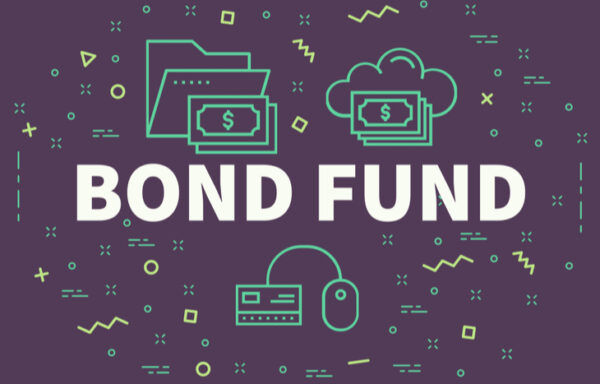What are Bond Funds?
Also called “debt funds,” bond funds are investment vehicles comprised entirely of debt instruments. They take the form of mutual funds or Exchange-Traded Funds (ETFs), pooling together fixed-income securities and other debt investments to provide investors with both a hedge against stock market volatility and access to passive income.
These funds are a traditionally conservative style of investing: low-risk, low-reward. However, they can serve as both compliments to a balanced portfolio strategy or as the foundation for a passive-income portfolio for retirees. Today’s landscape of bond funds includes a wide range of fund types and strategies, all focused around debt instruments: from U.S. Treasuries to junk bonds.
Here’s a closer look at what these funds are, how they work and some examples of different fund options investors can choose from.

What’s in a Bond Fund?
As the name implies, bond funds can contain any number of debt securities—and they do. Some of the most common assets include U.S. Treasuries, corporate bonds, junk bonds and Treasury Inflation-Protected Securities (TIPS).
Not all funds will contain the same breadth of assets, however. The benefit of these funds is a diverse range of options designed to cater to different investment preferences and profiles. Some examples include:
- Corporate Funds
- Emerging Market Funds
- Global Funds
- High-Yield Funds
- Mortgage-Backed Securities Funds
- Municipal Funds
- U.S. Government Bond Funds
For instance, an investor might choose a fund comprised of TIPS as a way to hedge against inflation. Someone with a little more risk tolerance may buy into a fund comprised of higher-interest corporate bonds. The composition of the fund depends on the strategy used to architect it. Time horizon, risk factors, bond type and more all contribute to which debt securities make it into a bond fund.
The Goals of a Bond Fund
Bond funds have two primary goals: to generate passive income and to hedge against stock market volatility. How investors capitalize on these two benefits depends on their investment strategy.
- Passive income. Retirees and investors seeking passive income invest in funds because of their efficiency. Bond funds hold a collection of bonds with diverse coupon rates and maturities, which makes for a more regular stream of income—even against a bond ladder. As the fund’s assets mature and it adds new bonds, investors benefit from fluctuating monthly coupon payments.
- Hedge against risk. As low-risk, low-reward investments, bonds are historically less volatile than stocks. The added diversity that comes from a bond fund makes them even more stable in the face of volatility. As a result, many balanced portfolio investors use bond funds to hedge against a larger stock portfolio. While interest rate risk is still a factor investors need to consider, it’s a much less prevalent one.
These two objectives make bond funds among the most stable investments out there. And while it’s possible to tinker with levels of risk and reward based on the fund type—such as a safe TIPS-focused fund vs. an emerging market bond fund—investors can nevertheless expect relative reliability from these products. They’re designed to be portfolio stalwarts.
What is a Mutual Fund?
A mutual fund is a diversified investment vehicle that’s actively managed by a fund manager. These funds typically have minimum buy-in requirements, and shares sell for the Net Asset Value (NAV) of the fund. Investors pay an annual management fee to hold shares of the mutual fund, called an expense ratio. The chief benefit of bond mutual funds is the active management: adjustments to the fund’s allocation based on changing creditworthiness or interest rates.
Bond mutual funds focus specifically on debt securities. The fund holds hundreds if not thousands of different fixed-income assets with varying maturity dates, with varying coupon rates. These mutual funds pay out lump sum coupon payments monthly, making them great passive income investment vehicles for retirees.
What is an Exchange-Traded Fund?
An ETF functions similar to a bond mutual fund, with a few key differences. ETFs don’t have minimum buy-in amounts, which makes them more liquid and accessible to everyday investors. They also typically have much lower expense ratios because they’re not actively managed. Instead, they’re pegged to an underlying bond index.
The benefits of a bond ETF are largely the same as a mutual fund, with a higher risk-reward. Without management, investors in bond ETFs leave themselves open to interest rate risk unless they actively oversee their investments. However, lower fees and better liquidity make bond ETFs easier to capitalize on—especially since ETF prices change throughout a normal trading period.
How to Capitalize on Bond Funds
Bond funds provide two important benefits to conservative investors: passive income and a hedge against volatility. Combined, these factors make them ideal for passive income investors such as retirees. Those seeking bond exposure as part of a balanced investment portfolio will find themselves drawn toward funds with higher risk-reward ratios, such as high-yield bond funds. In either case, these funds serve to create stability.
Whether you invest in a bond mutual fund or a bond ETF comes down to preference. Long-term investors tend to see the value in paying for managed funds—especially if the passive income from a mutual fund is consistent and sizable. Investors who want more control over their exposure to debt securities will appreciate the liquidity and low-cost nature of ETFs. In either case, bond funds are one of the best ways to get broad exposure to fixed-income securities without buying individual bonds.





